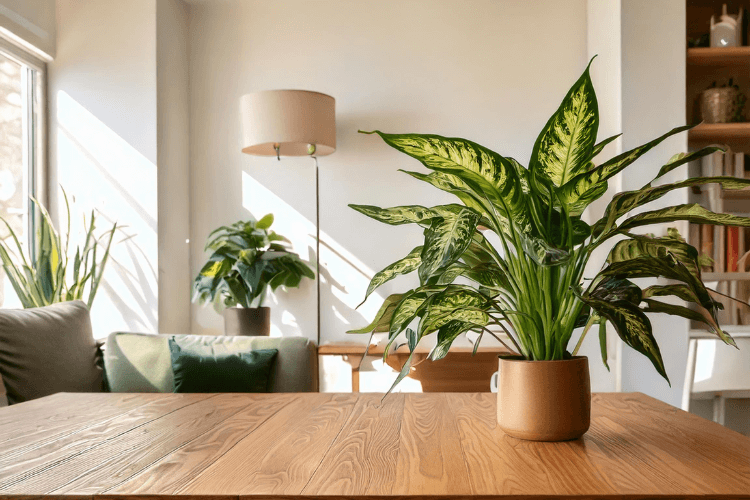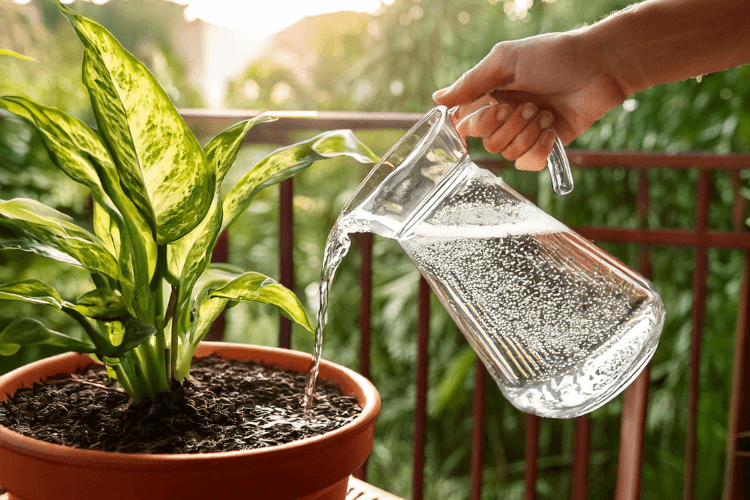Imagine transforming your living space with a touch of natural elegance, brought to life by the lush, vibrant leaves of a Dieffenbachia plant. Also known as Dumb Cane, this tropical beauty is a favorite among plant enthusiasts for its low-maintenance nature and striking foliage. Whether you’re a seasoned plant parent or just starting your green journey, understanding the essentials of Dieffenbachia care can ensure your plant thrives for years to come.
In this guide, you’ll uncover everything you need to know about the Dieffenbachia plant, from light and watering needs to propagation techniques and troubleshooting common issues. Let’s dive in!
Table of Contents
Why Choose the Dieffenbachia Plant?

Aesthetic Appeal
The Dieffenbachia plant boasts large, variegated leaves in shades of green, cream, and white. Each leaf tells a unique story, making it a stunning centerpiece in any room. Popular varieties like Dieffenbachia Camille and Dieffenbachia Maculata are particularly admired for their intricate patterns and vibrant colors. Other types also share similar striking features.
Adaptable and Easy to Grow
One of the greatest advantages of the plant is its adaptability. Whether you place it in a bright corner or a dimly lit room, it adjusts with grace. As long as you follow basic care guidelines, your plant will flourish.
Air-Purifying Qualities
Did you know that the Dieffenbachia helps improve indoor air quality? It removes toxins and releases oxygen, creating a healthier environment for you and your family.
Setting Up the Perfect Environment for Your Dieffenbachia Plant
Before we dive into Dieffenbachia plant care, it’s important to ensure that the environment you provide is ideal for your plant’s growth. Here are a few key considerations to help you set up the perfect environment for your Dumb Cane plant:
Light Requirements for Healthy Growth
It flourishes in bright, indirect light but is also capable of adapting to lower light settings. However, it’s essential to avoid placing it in direct sunlight, as this can scorch the delicate leaves. If you notice the edges of your plant’s leaves turning brown, it’s a sign that the plant is receiving too much direct sunlight.
While Dieffenbachia plants can adapt to lower light conditions, they do best when given moderate light exposure. A spot near a window with sheer curtains or a location that gets filtered light is ideal. Too little light will cause the plant to become leggy and weak, so make sure it’s getting enough light, but not too much.
Soil and Potting Tips

The soil you choose plays a crucial role in your plant’s health. A well-draining potting mix that holds moisture without becoming waterlogged is essential for root health. A mixture of peat, perlite, and pine bark works well for most varieties.
When repotting your Dieffenbachia, ensure that the pot has drainage holes. This prevents water from accumulating at the bottom and causing root rot, a common problem for these plants. Re-potting should be done every two to three years, especially when it outgrows its current pot.
Ideal Temperature and Humidity
This plant enjoys warm temperatures, typically between 65–75°F (18–24°C), which mirrors its natural tropical habitat in regions like Central and South America. These temperature ranges help maintain the plant’s lush, green foliage. Keep it away from cold drafts, such as those near windows or air conditioners, as these can cause stress and damage the leaves, leading to browning or curling, especially along the edges.
In addition to temperature, humidity is a critical factor for your Dumb Cane plant. Dieffenbachia plants love humidity and thrive in a more humid environment. In dry climates, using a humidifier or placing a water-filled tray near the plant can help boost humidity levels. Occasionally misting the leaves is another way to enhance humidity for the plant. If the air is too dry, the plant may develop brown tips, especially on the leaves.
Essential Dieffenbachia Care Practices
To keep your Dieffenbachia plant healthy and thriving, regular care and attention are necessary. Here’s a breakdown of the most important aspects of Dieffenbachia care:
Watering Needs

Proper watering is key to keeping your Dieffenbachia plant happy. Like many tropical plants, it prefers to have its soil consistently moist but not soggy. Water your plant when the top inch of the soil feels dry to the touch, and make sure the water drains well after each watering.
Overwatering is one of the biggest mistakes you can make when caring for your Dieffenbachia plant. Standing water in the pot can cause the roots to rot, so always ensure that excess water can drain away freely. During the winter months, reduce watering slightly, as the plant is in a period of slower growth.
Fertilization Schedule
Fertilizing your Dieffenbachia plant ensures that it has the nutrients it needs to thrive. Throughout the growing season, which spans spring and summer, nourish your plant monthly with a well-balanced liquid fertilizer. This helps encourage healthy growth and vibrant foliage.
However, it’s important not to over-fertilize. Too much fertilizer can lead to Dieffenbachia problems, such as burnt leaf edges or slow growth. In the fall and winter months, reduce fertilizing to once every two months, as the plant’s growth slows down.
Pruning for Shape and Health
Pruning is an important aspect of Dieffenbachia plant care. Regularly remove dead or yellowing leaves to promote new growth and maintain the plant’s shape. If your plant becomes too tall or leggy, you can also prune back the top stems to encourage bushier growth.
When pruning, always use clean, sharp scissors or pruning shears to avoid introducing disease or pests to your plant. After cutting, sterilize your tools with rubbing alcohol to maintain a healthy environment for your Dieffenbachia plant.
Common Dieffenbachia Problems and How to Solve Them
Despite being relatively easy to care for, Dieffenbachia plants can experience a few common problems. Here’s how to address them:
Yellowing Leaves
Cause: Overwatering or insufficient light.
Solution: Adjust your watering schedule and ensure your plant gets adequate indirect sunlight.
Brown Tips
Cause: Low humidity or over-fertilization.
Solution: Increase humidity and dilute fertilizer to avoid overfeeding.
Pests and Diseases
Common pests include spider mites and aphids. To tackle infestations, use neem oil or insecticidal soap. For bacterial issues, isolate the plant and remove infected leaves.
Dieffenbachia Propagation: Step-by-Step Guide
How to Propagate Dieffenbachia
Expanding your plant family is easier than you think. Follow these methods for successful propagation:
Stem Cuttings
- Choose a Healthy Stem: Look for a stem with 2–3 nodes.
- Cut and Prepare: Use clean shears to cut just below a node.
- Place in Water or Soil: Submerge the cut end in water or plant it in moist soil.
- Provide Care: Keep in a warm, bright spot until roots form.
Air Layering
- Select a Stem: Pick a healthy stem for layering.
- Wrap with Moss: Cover the selected area with damp sphagnum moss and plastic wrap.
- Wait for Roots: Once roots form, cut below the moss and plant.
Propagation Table
| Step | Instructions |
|---|---|
| Cut the stem | Choose a healthy stem with 2–3 nodes. |
| Prepare the medium | Place in water or moist potting soil. |
| Wait for roots | Keep in a warm, bright spot until roots develop. |
Popular Dieffenbachia Varieties to Consider for Your Home
The diverse world of Dieffenbachia varieties means there’s something for every plant lover. Here are some favorites:
- Dieffenbachia Camille: Known for its creamy white leaves, perfect for brightening up your space.
- Dieffenbachia Seguine: One of the most common varieties, featuring attractive green and white patterned leaves.
- Dieffenbachia Amoena: A variety with large, striking leaves that can grow up to 3 feet in length.
Each of these varieties requires the same care, but their different patterns and sizes can offer variety in your indoor garden.
Caring for Dieffenbachia Plants in the Long Term
To ensure that your Dieffenbachia plant remains healthy for years, here are a few long-term care tips:
- Rotate the pot: To encourage even growth, rotate your plant every few weeks.
- Clean the leaves: Use a damp cloth to gently clean the leaves of dust and debris, allowing the plant to absorb more light.
- Watch for pests: Regularly check for signs of pests and treat accordingly.
FAQs
Q: Can the Dumb Cane plant thrive in low light?
A: Yes, but it will grow best in bright, indirect sunlight.
Q: How often should I water my Dieffenbachia Seguine?
A: Water when the top inch of soil feels dry. Overwatering is a common mistake, so ensure the pot drains well.
Q: Is the Dieffenbachia plant toxic to pets?
A: Yes, the sap is toxic if ingested, so keep it out of reach of animals and children.
Conclusion
Bringing a Dieffenbachia plant into your home is a rewarding experience. With its lush foliage and minimal maintenance needs, it’s a wonderful addition to any space. By following the tips in this guide, you can ensure your plant thrives for years to come.
Ready to transform your space? Share your own tips or ask questions in the comments below!

